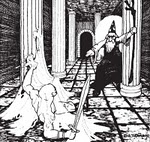Web
(Evocation)

Web
(Evocation)

|
|
|
|
|
|
|
|
|
|
|
|
|
|
|
|
|
|
Area: The web
spell covers a max. AREA of 8 cubic inches,
and the webs must be at
least 1" thick,
so a mass 4" high, 2" wide,
and 1" deep may be CAST.
Saving
Throw: Save is made at -2.
If the save vs. web is made,
two results may have occurred.
If the creature has room
to escape then he is assumed to have jumped free.
If there is no room to escape
then the webs are only 1/2 strength.
Effect: A web
spell creates a many-layered mass of
strong, sticky strands similar
to spider webs, but far larger and tougher.
These masses must be anchored
to two or more points-floor and ceiling,
opposite walls, etc. --
diametrically opposed.
Creatures caught within
webs, or simply touching them, become stuck amongst the gluey fibers.
Creatures with less than
13
STR must remain FAST until freed by another or until the spell wears
off.
For every full turn entrapped
by a web, a creature has a 5% cumulative chance of suffocating to death.
Creatures with STR between
13 and 17 can break through 1' of webs per turn.
Creatures with 18 or greater
STR break through 1' of webs per round.
(N.B. Sufficient mass equates
to great STR in this case, and great mass will hardly notice webs.)
Strong && huge creatures
will break through 1' of webs per segment.
It is important to note
that the strands of a web spell are flammable.
A magic flaming sword will
slash them away as easily as a hand brushes away cobwebs.
Any fire
-- torch, flaming oil, flaming sword,
etc. -- will set them alight and burn them away in a single round.
All creatures within the
webs will take 2-8 HP of damage
from the flames, but those freed of the strands will not be harmed.
DMG: If this spell
is CAST without two firm anchoring places,
the webs collapse and entangle
themselves,
effectively negating the
spell.
MC: A bit of spider web.
Web can effectively entangle
several opponents at once.
WSG:
Can be used to form a “net” beneath a character or an
object in danger of falling,
as long as two diametrically opposed
vertical surfaces (two cliff
faces close together, for instance) are
available to serve as anchors
for the web. For every five feet of
thickness of the web, it
can protect a character from a fall of 10
feet; a 10-foot-thick web
will stop a fall of 20 feet, one of 20 feet in
thickness will cushion a
character who falls 40 feet, and one of 30
feet in thickness or more
will stop a fall of 60 feet. If a character
falls more than 60 feet,
a web will be of no use; his body will have
built up so much velocity
that it will keep falling as though the web
wasn’t there. If a web is
used to halt a tumble down a slope, the
distance figures given above
are doubled for a severe slope,
quadrupled for a moderate
slope, and multiplied by eight for a
gentle
slope. For example, a 1 “-thick web will halt a character after
a tumble of 40 feet (or
less) down a severe slope; a 2”-thick
web will bring a character
safely to a halt after a fall of 160 feet (or
less) down a moderate slope.
Of course, the web does not negate
abrasion damage from a tumble,
but it does prevent the character
from suffering impact damage.
"Utzilah qazlem vinaquirem ta puch a ya vi!" (The Dragonlance Saga, Book I : A TSR Graphic Novel)
>